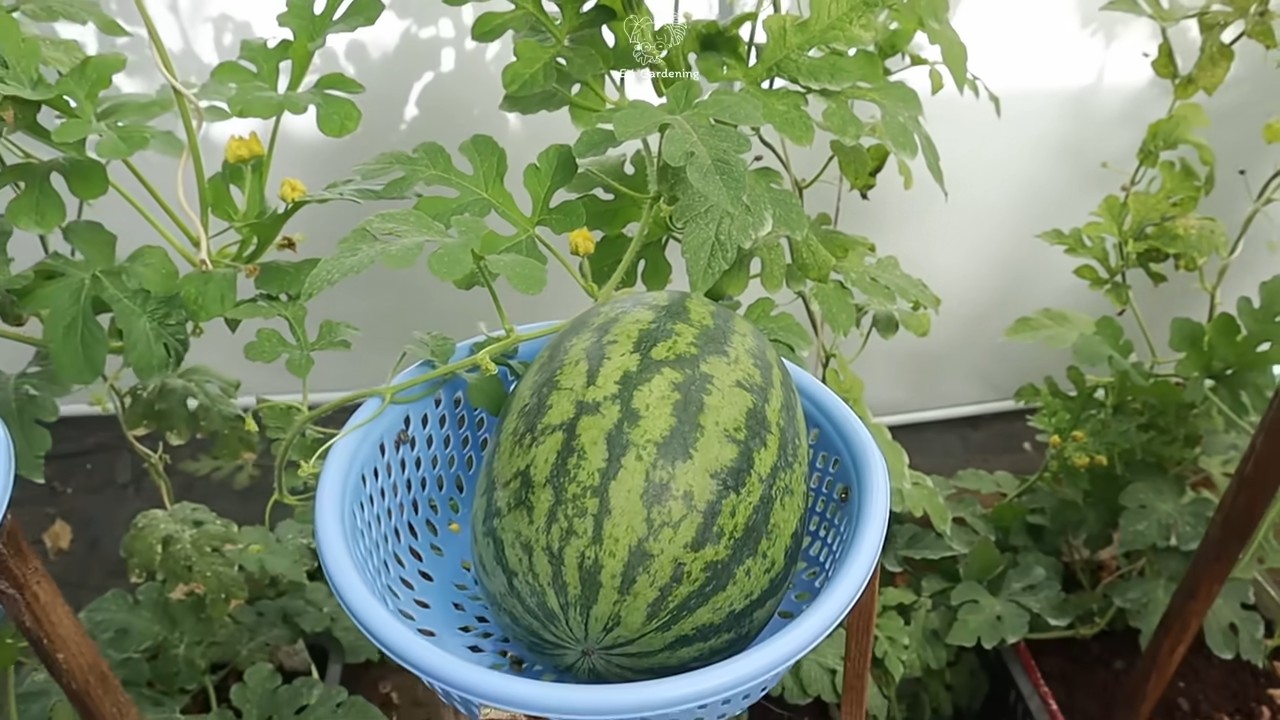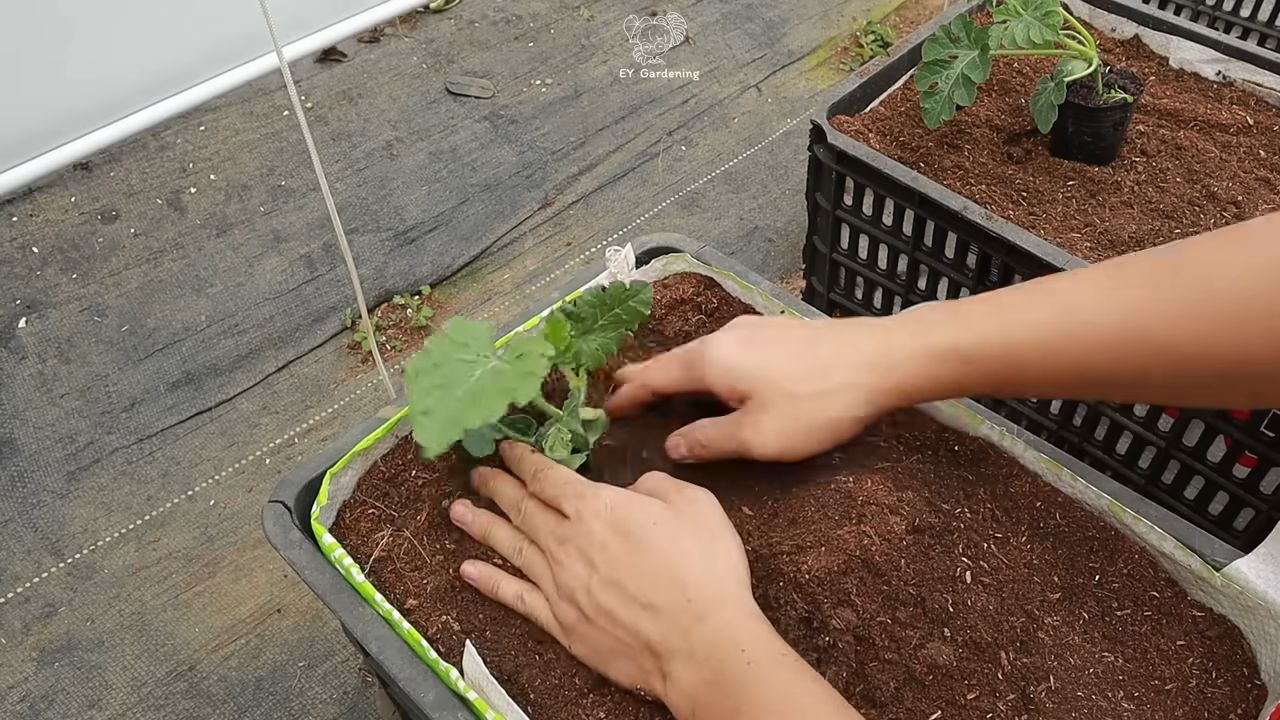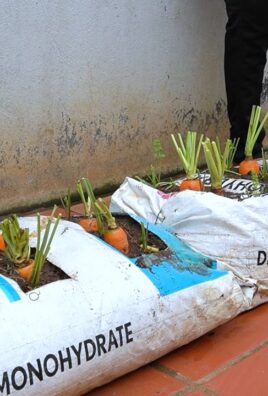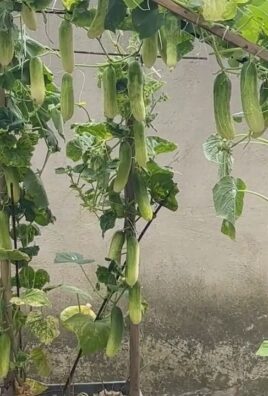Grow Watermelons at Home? Absolutely! Imagine biting into a juicy, sweet watermelon that you nurtured from seed to fruit, right in your own backyard. Forget those bland, store-bought melons – we’re talking about homegrown flavor that bursts with sunshine and satisfaction.
For centuries, watermelons have been a symbol of summer, abundance, and community. Originating in Africa, they’ve traveled the globe, becoming a beloved treat in countless cultures. Think of picnics, family gatherings, and the sheer joy of spitting seeds – it’s all part of the watermelon experience! But what if you could elevate that experience by growing your own?
Many people shy away from the idea of growing watermelons, thinking it’s too difficult or requires acres of land. But I’m here to tell you that’s simply not true! With a few clever tricks and DIY hacks, you can successfully grow watermelons at home, even in small spaces. This article is packed with easy-to-follow tips and techniques that will empower you to cultivate your own delicious watermelons, save money, and enjoy the unparalleled taste of homegrown goodness. So, grab your gardening gloves, and let’s get started on this exciting journey!

Grow Your Own Juicy Watermelons: A Beginner’s Guide
Hey there, fellow gardening enthusiasts! Ever dreamt of biting into a sweet, juicy watermelon you grew yourself? Well, dream no more! Growing watermelons at home might seem daunting, but trust me, with a little patience and the right know-how, you can absolutely do it. I’m going to walk you through everything you need to know, from choosing the right variety to harvesting your prize-winning melon. Let’s get started!
Choosing the Right Watermelon Variety
First things first, you need to pick a watermelon variety that suits your climate and garden space. Not all watermelons are created equal! Some are better suited for shorter growing seasons, while others need plenty of room to sprawl.
* Consider your climate: If you live in a region with a short growing season, opt for faster-maturing varieties like ‘Sugar Baby’ (around 75 days) or ‘Bush Sugar Baby’ (perfect for containers!). For longer, warmer climates, you have more options, such as ‘Crimson Sweet’ (around 85 days) or ‘Charleston Gray’ (around 90 days).
* Think about space: Watermelons are vines, and they need room to spread. If you have a small garden, consider bush or compact varieties. These are bred to be more contained. Vining varieties can be trained to grow up a trellis to save space, but this requires extra effort.
* Flavor preferences: Do you prefer a super sweet, red-fleshed watermelon? Or maybe a yellow or orange-fleshed one? Read descriptions carefully to find a variety that matches your taste. Some popular choices include:
* ‘Sugar Baby’: Classic, sweet, and relatively small.
* ‘Crimson Sweet’: Large, juicy, and disease-resistant.
* ‘Yellow Doll’: Yellow flesh, very sweet, and early maturing.
* ‘Blacktail Mountain’: Cold-tolerant and matures quickly.
* Disease resistance: Look for varieties that are resistant to common watermelon diseases like Fusarium wilt and Anthracnose. This will save you a lot of headaches down the road.
Preparing Your Garden Bed
Watermelons are heavy feeders, meaning they need a lot of nutrients to thrive. So, preparing your garden bed properly is crucial.
* Sunlight: Watermelons need at least 6-8 hours of direct sunlight per day. Choose a location in your garden that gets plenty of sun.
* Soil: Watermelons prefer well-drained, sandy loam soil with a pH between 6.0 and 6.8. If your soil is heavy clay, amend it with plenty of compost and other organic matter to improve drainage.
* Nutrients: Watermelons need a lot of nitrogen, phosphorus, and potassium. Before planting, amend your soil with compost, well-rotted manure, or a balanced fertilizer (like 10-10-10).
* Raised beds: Consider growing watermelons in raised beds. Raised beds warm up faster in the spring and provide excellent drainage.
Starting Watermelon Seeds (Indoors or Outdoors)
You can either start watermelon seeds indoors or directly sow them in your garden. Starting indoors gives you a head start, especially in cooler climates.
Starting Seeds Indoors:
1. Timing: Start seeds indoors about 3-4 weeks before the last expected frost.
2. Containers: Use peat pots or biodegradable pots. Watermelons don’t like to have their roots disturbed, so these pots can be planted directly into the ground, minimizing transplant shock.
3. Soil: Use a seed-starting mix.
4. Planting: Sow 2-3 seeds per pot, about 1 inch deep.
5. Watering: Keep the soil consistently moist but not soggy.
6. Warmth: Watermelon seeds need warmth to germinate. Use a heat mat to keep the soil temperature between 80-90°F (27-32°C).
7. Light: Once the seeds germinate, provide plenty of light. Place the seedlings under grow lights or in a sunny window.
8. Thinning: Once the seedlings have their first true leaves, thin them to one strong seedling per pot.
9. Hardening off: Before transplanting the seedlings outdoors, you need to harden them off. This means gradually exposing them to outdoor conditions over a period of 7-10 days. Start by placing them in a sheltered spot for a few hours each day, gradually increasing the amount of time they spend outdoors.
Direct Sowing Seeds Outdoors:
1. Timing: Sow seeds directly in the garden after the last expected frost, when the soil temperature is at least 70°F (21°C).
2. Planting: Sow seeds about 1 inch deep, spacing them according to the variety’s recommendations (usually 2-3 feet apart).
3. Watering: Keep the soil consistently moist until the seeds germinate.
4. Protection: Protect young seedlings from pests and cold weather with row covers or cloches.
Transplanting Watermelon Seedlings
Once your seedlings are hardened off (or if you direct-sowed and they’ve sprouted), it’s time to transplant them into your prepared garden bed.
1. Timing: Transplant seedlings on a cloudy day or in the late afternoon to minimize stress.
2. Spacing: Space plants according to the variety’s recommendations. Bush varieties can be planted closer together than vining varieties.
3. Planting: Dig a hole slightly larger than the root ball of the seedling. Gently remove the seedling from its pot (if using peat pots, you can plant the whole pot). Place the seedling in the hole and backfill with soil.
4. Watering: Water thoroughly after planting.
5. Mulching: Mulch around the plants with straw or other organic mulch to help retain moisture, suppress weeds, and keep the soil warm.
Caring for Your Watermelon Plants
Now that your watermelon plants are in the ground, it’s time to give them the care they need to thrive.
* Watering: Watermelons need consistent moisture, especially during fruit development. Water deeply and regularly, especially during dry spells. Avoid overhead watering, which can promote fungal diseases. Soaker hoses or drip irrigation are ideal.
* Fertilizing: Side-dress your watermelon plants with a balanced fertilizer every 2-3 weeks. You can also use a liquid fertilizer, such as fish emulsion or seaweed extract.
* Weeding: Keep the area around your watermelon plants free of weeds. Weeds compete with watermelons for nutrients and water.
* Pest control: Watermelons can be susceptible to pests like aphids, squash bugs, and cucumber beetles. Inspect your plants regularly and take action if you see signs of infestation. Insecticidal soap or neem oil can be effective for controlling many pests.
* Pollination: Watermelons need to be pollinated to produce fruit. If you’re not seeing any fruit set, you may need to hand-pollinate the flowers. To hand-pollinate, use a small paintbrush to transfer pollen from the male flowers to the female flowers. Female flowers have a small swelling at the base of the flower (the developing fruit).
* Vine training (optional): If you’re growing vining watermelons and want to save space, you can train them to grow up a trellis. This requires some extra effort, as you’ll need to tie the vines to the trellis as they grow.
Protecting Your Watermelons
As your watermelons grow, they can be vulnerable to various threats.
* Sunscald: Watermelons can get sunscald if they’re exposed to too much direct sunlight. Protect them by shading them with shade cloth or by placing straw or other organic material over them.
* Pests: Groundhogs, raccoons, and other animals love watermelons. Protect your watermelons by fencing them in or by using netting.
* Diseases: Watermelons can be susceptible to fungal diseases like Fusarium wilt and Anthracnose. Prevent these diseases by providing good air circulation, avoiding overhead watering, and using disease-resistant varieties.
Harvesting Your Watermelons
The moment you’ve been waiting for! Knowing when to harvest your watermelons is key to getting that perfect, sweet flavor.
* Days to maturity: Check the seed packet or plant tag for the variety’s days to maturity. This is a good starting point, but it’s not always accurate.
* Tendril: The tendril closest to the watermelon should be brown and dry.
* Ground spot: The spot where the watermelon rests on the ground (the ground spot) should be yellow or cream-colored. If it’s white or green, the watermelon is not ripe yet.
* Thumping

Conclusion
So, there you have it! Growing watermelons at home might seem daunting at first, but with a little planning, patience, and the right techniques, you can be harvesting your own juicy, sweet watermelons before you know it. This isn’t just about saving money; it’s about experiencing the unparalleled satisfaction of nurturing a plant from seed to fruit, knowing exactly what went into its growth, and enjoying a flavor that far surpasses anything you can find in a store.
This DIY approach to watermelon cultivation offers a level of control and customization that’s simply unavailable when purchasing commercially grown fruit. You get to choose the variety that best suits your taste and climate, ensuring a truly personalized watermelon experience. Imagine biting into a sun-ripened, homegrown watermelon, bursting with flavor and knowing you nurtured it from a tiny seed. That’s an experience worth striving for.
But the benefits extend beyond just taste. Growing your own watermelons is a fantastic way to connect with nature, learn about the growing process, and even get some exercise in the process. It’s a rewarding hobby that can be enjoyed by the whole family, teaching children about where their food comes from and fostering a love for gardening.
Don’t be afraid to experiment! Try different varieties of watermelons to find your favorite. Consider using companion planting techniques to deter pests and improve soil health. Explore vertical gardening methods if you’re short on space. The possibilities are endless! You can even try grafting your watermelon plants onto more vigorous rootstock for increased disease resistance and yield.
We’ve covered the basics, but remember that every garden is unique. Pay attention to your plants, observe their needs, and adjust your approach accordingly. Don’t be discouraged by setbacks; gardening is a learning process, and even experienced gardeners encounter challenges. The key is to persevere, learn from your mistakes, and keep experimenting.
Growing watermelons at home is not just a trend; it’s a sustainable and rewarding way to enjoy this delicious fruit. It’s about taking control of your food source, connecting with nature, and experiencing the joy of growing something yourself.
So, what are you waiting for? Grab some seeds, prepare your garden, and embark on your watermelon-growing adventure today! We’re confident that you’ll be amazed by the results. And most importantly, don’t forget to share your experiences with us! We’d love to hear about your successes, your challenges, and any tips or tricks you’ve discovered along the way. Share your photos and stories in the comments below – let’s build a community of homegrown watermelon enthusiasts! Let us know what variety you chose, what challenges you faced, and what you learned. Your insights could help other aspiring watermelon growers achieve their own sweet success.
Variations and Further Exploration
Consider exploring different watermelon varieties beyond the standard red-fleshed types. Yellow watermelons, orange watermelons, and even seedless varieties offer unique flavors and textures. Experiment with different soil amendments to optimize your soil’s fertility and drainage. Try using raised beds or containers if you have poor soil quality or limited space.
A Final Word of Encouragement
Remember, the journey of growing your own watermelons is just as rewarding as the final harvest. Embrace the process, learn from your experiences, and enjoy the fruits (or rather, watermelons) of your labor. Happy gardening!
FAQ
What is the best time to start watermelon seeds indoors?
The ideal time to start watermelon seeds indoors is typically 4-6 weeks before the last expected frost in your area. This allows the seedlings to develop a strong root system before being transplanted outdoors. Check your local weather forecasts and planting guides to determine the average last frost date for your region. Starting too early can result in leggy, weak seedlings, while starting too late may shorten the growing season and reduce your chances of a successful harvest.
How much space do watermelon plants need?
Watermelon plants are sprawling vines that require a significant amount of space to grow. Generally, you should allow at least 3-4 feet between plants in a row and 6-8 feet between rows. This spacing allows the vines to spread out without overcrowding each other, ensuring adequate sunlight and airflow. If you’re growing watermelons in containers, choose large containers that are at least 24 inches in diameter and depth. For smaller, bush-type watermelon varieties, you might get away with slightly less space, but always err on the side of giving them more room to thrive.
What kind of soil is best for growing watermelons?
Watermelons thrive in well-drained, sandy loam soil that is rich in organic matter. The soil should have a slightly acidic pH, ideally between 6.0 and 6.8. Before planting, amend the soil with compost, well-rotted manure, or other organic materials to improve its fertility and drainage. Avoid heavy clay soils, as they can retain too much moisture and lead to root rot. If you have clay soil, consider growing watermelons in raised beds or containers filled with a suitable potting mix.
How often should I water my watermelon plants?
Watermelon plants need consistent moisture, especially during hot, dry weather. Water deeply and regularly, aiming to keep the soil consistently moist but not waterlogged. A good rule of thumb is to water 1-2 inches per week, depending on the weather conditions. During fruit development, increase the watering frequency to support the growing melons. Use a soaker hose or drip irrigation to deliver water directly to the roots, minimizing water loss through evaporation and reducing the risk of fungal diseases. Reduce watering as the fruits ripen to concentrate the sugars and improve their flavor.
How do I know when my watermelons are ripe?
Determining when a watermelon is ripe can be tricky, but there are several indicators to look for. First, check the tendril closest to the fruit stem; it should be brown and dry. Second, examine the spot where the watermelon rests on the ground; it should be yellow or creamy in color. Third, thump the watermelon; a ripe watermelon will sound hollow and deep. Finally, consider the number of days from planting; most watermelon varieties take 70-90 days to mature. With practice, you’ll develop a feel for when your watermelons are perfectly ripe and ready to harvest.
What are some common pests and diseases that affect watermelons?
Watermelons can be susceptible to various pests and diseases, including aphids, squash bugs, vine borers, powdery mildew, and fusarium wilt. Regularly inspect your plants for signs of infestation or disease. Use organic pest control methods, such as insecticidal soap or neem oil, to control aphids and squash bugs. Protect your plants from vine borers by wrapping the stems with aluminum foil or netting. Prevent powdery mildew by ensuring good air circulation and avoiding overhead watering. Choose disease-resistant watermelon varieties to minimize the risk of fusarium wilt.
Can I grow watermelons in containers?
Yes, you can successfully grow watermelons in containers, especially bush or dwarf varieties. Choose a large container that is at least 24 inches in diameter and depth. Use a high-quality potting mix that is well-draining and rich in organic matter. Provide a trellis or support for the vines to climb on. Water regularly and fertilize with a balanced fertilizer every 2-3 weeks. Place the container in a sunny location that receives at least 6-8 hours of direct sunlight per day.
How can I improve the sweetness of my watermelons?
Several factors can influence the sweetness of your watermelons. Choose a watermelon variety that is known for its sweetness. Ensure that your plants receive adequate sunlight, water, and nutrients. Avoid over-watering as the fruits ripen, as this can dilute the sugars. Add potassium-rich fertilizer to the soil to promote sugar production. Protect your watermelons from pests and diseases, as these can weaken the plants and reduce their ability to produce sweet fruit.
What are some good companion plants for watermelons?
Companion planting can help improve the growth and health of your watermelon plants. Some good companion plants for watermelons include marigolds, nasturtiums, and radishes, which can deter pests. Basil and oregano can also help repel insects. Sunflowers can provide shade and support for the vines. Legumes, such as beans and peas, can fix nitrogen in the soil, benefiting the watermelons. Avoid planting watermelons near potatoes or other members of the cucurbit family (e.g., cucumbers, squash), as they can compete for resources or attract similar pests and diseases.
How do I save watermelon seeds for next year?
Saving watermelon seeds is a great way to preserve your favorite varieties and save money. Choose a ripe, healthy watermelon and scoop out the seeds. Rinse the seeds thoroughly to remove any pulp. Spread the seeds out on a paper towel to dry completely, which may take several days. Once the seeds are dry, store them in an airtight container in a cool, dark, and dry place. Properly stored watermelon seeds can remain viable for several years.




Leave a Comment